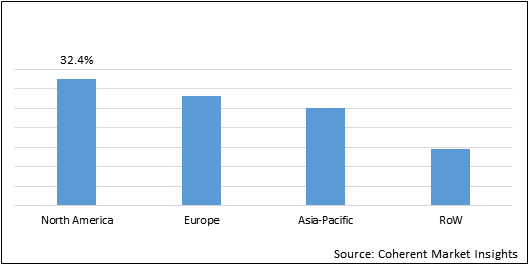Thermal imaging technology is a method of enhancing the object’s visibility in a totally dark environment by detection of infrared radiation emitted by an object and interpreting these radiations to create a visible pattern (image). This technology captures the upper layer of the infrared light spectrum. It best works in a dark environment without any ambient light and can see through fog, smoke, haze, and is capable of catching moving objects in real-time. There are two types of thermal imaging devices namely un-cooled devices and cryogenically cooled devices.
The global Thermal Imaging Market was accounted for US$ 1,978.7 Mn in terms of value in 2019 and is expected to grow at CAGR of 9.7% for the period 2020-2027.
Market Dynamics- Drivers
Thermal imaging technology is widely used in military and defense equipment, which accounts for over 40% of the total global thermal imaging market. Increase in investment by governments of various countries such as China, India, the U.K., and Russia for up-gradation and modernization of weapons and equipment in the armed forces is one of the major factors driving the growth of the thermal imaging market. Thermal imaging devices offer armed forces, the ability to see in dark environment by generating a reliable and identifiable image of the environment based on radiation emitted by objects. Countries such as India, China, and the U.K. are improving effectiveness and capabilities of their armed forces and enhancing command, control, and interoperability by investing in thermal imaging. For instance, in 2013, Thales Group received a contract from the German Armed Force to supply sets of long-range cooled thermal imagers named Sophie XF. Thus, these factors are expected to drive growth of the global thermal imaging market during the forecast period.
Thermal imaging technology is being used in numerous fields apart from military and defense. These sectors include healthcare, commercial, and other applications. Furthermore, the energy audit sector has provided new opportunities for thermal imaging technology, particularly in preventative maintenance. Automobile industry is incorporating thermal imaging cameras in cars to reduce the potential dangers of accidents at night. For instance, BMW and Audi have deployed thermal imaging cameras in cars that help in detecting living objects such as pedestrians and animals, which are difficult to spot in the dark. Moreover, thermal imaging technology is used in the healthcare sector to protect animals and humans from disease. Thus, these factors are expected to propel the global thermal imaging market growth over the forecast period.
Thermal Imaging Market - Impact of Coronavirus (Covid-19) Pandemic
Thermal Imaging is majorly used for the security and surveillance purposes. It is widely used in the military and defense equipment. Owing to the COVID-19 pandemic, several governments around the globe are forced to increase the spending on healthcare and safeguarding the economy. For instance, In July 2020, Government of Thailand reduced defense budget from US$ 7.45 Billion in 2020 to US$ 7.18 Billion for 2021. Currently Several government are majorly focusing on the healthcare industry than the defense industry. Owing to the reduced defence budgets, many governments are less likely to buy military equipment such as Thermal Imaging in the year 2020-2021.
Thermal Imaging Market Report Coverage
| Report Coverage | Details | ||
|---|---|---|---|
| Base Year: | 2019 | Market Size in 2019: | USD 1,978.7 Mn |
| Historical Data for: | 2017 to 2019 | Forecast Period: | 2020 to 2027 |
| Forecast Period 2020 to 2027 CAGR: | 9.7% | 2027 Value Projection: | USD 4,180.1 Mn |
| Geographies covered: |
|
||
| Segments covered: |
|
||
| Companies covered: |
FLIR Systems Inc. (FLIR), Raytheon Company, BAE Systems Inc., L-3 Communications Holdings, Inc., Axis Communications AB, Danaher Corporation, and DRS Technologies Inc. |
||
| Growth Drivers: |
|
||
| Restraints & Challenges: |
|
||
Uncover macros and micros vetted on 75+ parameters: Get instant access to report
Market Dynamics- Restraints
Many developed countries in North America and Europe have started reducing their budget for military and defense. This has negatively affected the regional thermal imaging market. For instance, the U.S. and a few European countries namely Italy and France have reduced their spending on armed forces. These countries have a bigger share of the total thermal imaging market and budgetary cuts in these countries on up-gradation of weapons and other equipment are adversely affecting market growth. Thus, these factors are expected to restrain growth of the global thermal imaging market during the forecast period.
Many countries have imposed stringent restrictions on the export of certain thermal imaging products. According to the U.S. Department of State Office of Defense Trade Controls, the export of U.S. manufactured night vision equipment is strictly prohibited without a valid export license. The restrictions are in accordance with the International Traffic in Arms (ITAR), Title 22, Code of Federal Regulation Part 120-130. Thus, these factors are expected to hinder the global thermal imaging market growth over the forecast period.
Statistics:
North America held dominant position in the global Thermal Imaging market in 2019, accounting for 32.4% share in terms of value, followed by Europe and Asia Pacific respectively
Figure 1: Global Thermal Imaging market Share (%) in terms of Value, By Region, 2019
To learn more about this report, Download Free Sample
Market Opportunities
There is a huge scope for thermal imaging technology in PCs and smartphone applications. Thermal imaging devices require cooling technology, which in turn increases the cost. Key players such as FLIR Systems have introduced innovative devices namely lepton sensor, which is lighter, smaller, and hence, can be added to a smart-phone. In addition, it does not use an external cooler to run, which reduces the cost of thermal devices. FLIR Systems has also introduced a thermal imaging camera named FLIR ONE, which can be easily incorporated in smart-phones such as iPhone 5s.
Key companies are focused on research and development activities, in order to expand the market presence. For instance, in January 2014, FLIR Systems Inc. introduced thermal rifle scope hunters to enter new markets. This product includes models for military and law enforcement models. In October 2014, FLIR Systems Inc. introduced New E-Series thermography cameras. This product has been developed for pinpointing mechanical and electrical overheating. Furthermore, in September 2013, BAE Systems Inc. launched a thermal camera core named MIR640, which can see through fog and smoke.
Figure 2: Global Thermal Imaging market Value (US$ Mn), 2017 - 2027

To learn more about this report, Download Free Sample
The global Thermal Imaging market was valued at US$ 1,978.7 Mn in 2019 and is forecast to reach a value of US$ 4,180.1 Mn by 2027 at a CAGR of 9.7% between 2020 and 2027.
Market Trends
The introduction of high-resolution thermal imaging cameras has increased its adoption across applications such as remote and long-distance monitoring and surveillance. Manufacturers introduced thermal imaging camera with 640 x 480 resolutions that can be used for long-distance monitoring and surveillance. Furthermore, due to mass production, manufacturers have reduced the cost of high-resolution thermal imaging camera to make it affordable to end-users, mainly commercial and residential sectors. For instance, thermal imaging cores with 320 x 240 and 384 x 288 resolutions are available at an affordable prices (e.g. US$ 2500 to US$ 5000) which are increasingly being deployed in dual closed-circuit television (CCTV with thermal and video) and commercial applications for security and surveillance.
Major market players are focused on contracts and agreements, in order to gain a significant advantage in the market. For instance, in March 2012, L-3 Communications Holdings, Inc. entered into a US$ 50 million contract with the U.S. special operations command. According to this contract, the company would provide a new lighter and smaller night vision goggles to the U.S. special operations command. Furthermore, in April 2012, BAE Systems Inc. entered into a US$ 11 million contract with USSOCOM (The United States Special Operations Command).
Value Chain Analysis
Component suppliers
The market consists of a large number of suppliers of components required in making thermal imaging devices. Components namely video signal generators, IR lenses, detectors, video signal generators, and displays are provided by various component suppliers such as Vision Systems Design, FLIR Systems Inc. and Lightpath Technologies among others. In order to reduce the cost associated with producing components, key players may backward integrate. This will further reduce the dependency of key players on other component providers.
Competitive Section
Key players operating in the global thermal imaging market are FLIR Systems Inc. (FLIR), Raytheon Company, BAE Systems Inc., L-3 Communications Holdings, Inc., Axis Communications AB, Danaher Corporation, and DRS Technologies Inc.
Key Developments
Share
Share
Missing comfort of reading report in your local language? Find your preferred language :
Transform your Strategy with Exclusive Trending Reports :
Frequently Asked Questions
Select a License Type
Joining thousands of companies around the world committed to making the Excellent Business Solutions.
View All Our Clients